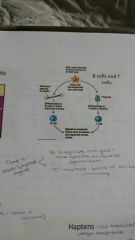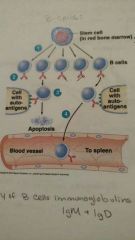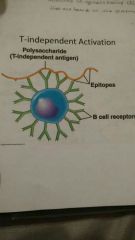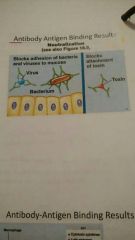![]()
![]()
![]()
Use LEFT and RIGHT arrow keys to navigate between flashcards;
Use UP and DOWN arrow keys to flip the card;
H to show hint;
A reads text to speech;
19 Cards in this Set
- Front
- Back
|
Adaptive Immunity |
Our body that is adapting to a pathogen and responding appropriately (3rd line of defense) |
|
|
Characteristics of Adaptive Immunity (A SIM U) |
Ability to clonality Specific Inducibility Memory Unresponsive to self |
|
|
Components of Adaptive Immunity |
B and T cells |
|
|
B cells |

Originate as stem cells -made in bone marrow and differentiate from stem cells -they then migrate to other lymph tissues in the body •waiting to encounter potential pathogens -involved in hummoral Immunity |
|
|
T Cells |

Made in thymus gland -differentiate from stem cells -migrate to other lymph tissues •also waiting in tissues to encounter potential pathogens |
|
|
Antigen-Antibody Interaction |
Another name for PAMPs |
|
|
Antigens |
Are composed of epitopes (individual patterns on antigen) -very different depending on the foreign particle. |
|
|
MHC (major histocompatibility complex) |
B cells show MHC on the plasma membrane of their cells for the T cells to see like a "silver platter" |
|
|
Selection/Deletion of clones |

Specific to B cells - stem cells in the bone marrow make many B cells, if B cells bind to autoantigens the apoptosis If not, then it will never interact with any of our cells and it is good to go into the blood |
|
|
Autoantigens |
Our antigens |
|
|
T dependant B cell activation |
T and B cells work together -B cells bind to extracellular antigen (very specific) -antigen is taken into the cell and put onto chemcial MHC -MHC proteins and antigens presented on B cell surface -T cell releases cytokines to active B cells -B cells transforms into plasma cells , creating antibodies |
|
|
Agglutination |

Act of clumping pathogens with antibodies resulting in immobilization -now easier seen by phagocyte to go through phagocytosis |
|
|
T cell independent B cell activation |

-repeated binding to epitopes on a surface = activation .....B cells will be activated and transform into plasma cells to make specific antibodies •this is a weaker response tho so no memory cells are made |
|
|
Antigen Binding Results |
Agglutination, opsonization, neutralization, activation of Complement, antibody dependant cell mediated cytotoxicity |
|
|
Opsonization |

Helping the macrophages find the pathogen and bind to them for the specific result of phagocytosis |
|
|
Neutralization |

Antibodies are coating bacteria , toxins, and viruses so they cannot cause disease |
|
|
Activation of Complement |

-antibody coat target organisms -complement binds FC region of antibody starting complement cascade |
|
|
Antibody dependant cell mediated cytotoxicity |

:target organism coated with antibodies |
|
|
Naturally acquired Immunity |
You interact with the pathogen naturally then u get disease once, memory cells are set aside and you never get it again |

